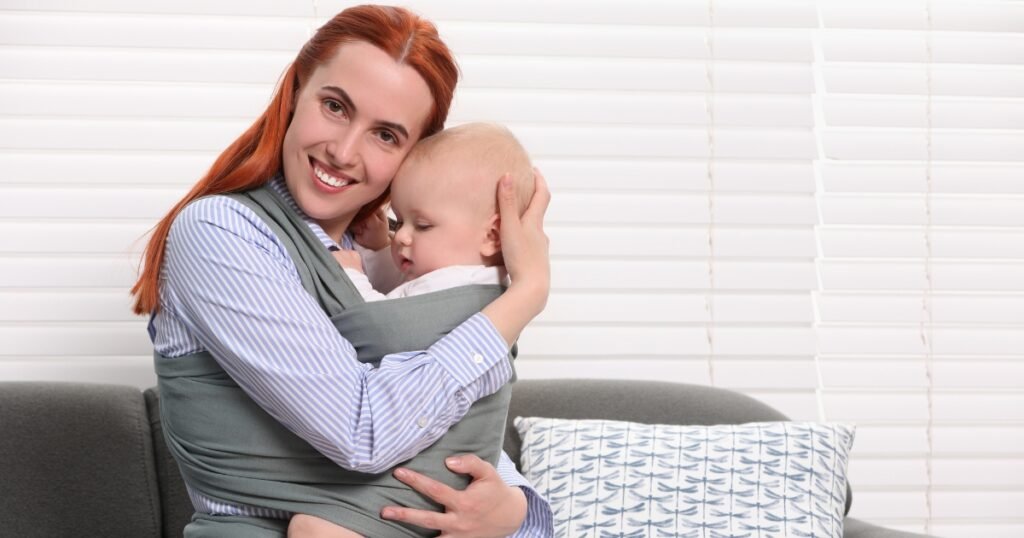Last Updated on 29 June 2024
As parents, we want nothing but the best for our babies. This includes providing them with a safe and comfortable way to explore the world around them. Baby carriers are a popular choice for parents who want to keep their little ones close while having their hands free. However, not all baby carriers are created equal, especially regarding the health and development of your baby’s hips. In this article, we will explore the importance of hip health in baby carriers and provide a list of the best hip healthy baby carriers that will ensure happy and healthy babies while also serving as a safe place for infants to nap or breastfeed while on the go.
How We Evaluated Baby Carriers
Choosing the best baby carrier can be daunting, with so many options on the market. To help you make an informed decision, we evaluated baby carriers based on several criteria. Here’s how we assessed each baby carrier:
- Hip Support: We considered whether the carrier promotes healthy hip development by properly supporting and positioning the baby’s hips. This is crucial for preventing hip dysplasia.
- Comfort: We evaluated the carrier’s comfort level for both the baby and the parent. Features like padded straps, lumbar support, and breathable materials provide a comfortable wearing experience.
- Durability: We assessed the carrier’s quality and durability to ensure that it can withstand regular use and last a long time.
- Ease of Use: We considered how easy it is to put on and remove the carrier, adjust the straps, and safely secure the baby. A carrier with a simple and intuitive design is ideal for busy parents.
- Safety: We looked for carriers that meet or exceed current safety standards set by the International Hip Dysplasia Institute, ensuring a secure and safe environment for the baby.
Based on these criteria, we selected the best hip healthy baby carriers that excel in all these aspects. These carriers offer babies and parents the best comfort, support, and safety.
The Best Hip Healthy Baby Carriers
Choosing the right baby carrier is crucial for your baby’s comfort and hip health. Here is a list of our best hip healthy baby carriers that are highly recommended by parents and experts:
Ergobaby Omni 360 Baby Carrier
Lillebaby Complete Carrier
Boba Baby Wrap Carrier
The Boba Wrap Baby Carrier is a soft, stretchy wrap that provides a snug and secure fit for newborns and infants. It is made from a cotton and spandex blend, allowing for easy and comfortable wrapping. The carrier supports the M-position, ensuring proper hip development.
BabyBjorn Baby Carrier One
The BabyBjörn Baby Carrier One is popular for its simplicity and ease of use. It has adjustable settings that accommodate your baby’s growth and ensure proper hip positioning. The carrier also has wide shoulder straps and a waist belt for optimal weight distribution.
Moby Evolution Wrap
The Moby Wrap Evolution Baby Carrier is made from lightweight, breathable fabric, perfect for warmer climates. It provides a snug and secure fit for newborns and infants and supports the M-position for proper hip development. The carrier also has a wide waistband for added support.
Importance of Hip Positioning in Carriers
Healthy hip development is crucial for your baby’s overall well-being. The International Hip Dysplasia Institute recommends baby carriers that support the M-position, where the thighs are spread apart and the hips and knees are bent. This position allows for proper hip development and reduces the risk of hip dysplasia. Baby carriers that restrict leg movement or keep the legs straight can increase the risk of hip dysplasia. It is important to choose a carrier that promotes healthy hip positioning and allows for free movement of the hips and head control.
Proper hip positioning in baby carriers is essential for healthy hip development, especially during the first 6 months of life when the hips are rapidly growing. Hip dysplasia is a common condition where the hip joint is misaligned or dislocated. Using a carrier that supports the M-position, with the thighs spread apart and the hips and knees bent, helps to prevent hip dysplasia.
This position allows the hip joint to develop properly and reduces the risk of long-term complications. Carriers that do not properly support the hips can put stress on the hip joint and increase the risk of hip dysplasia. It’s important to choose a carrier that promotes healthy hip positioning to ensure the comfort and well-being of your baby.
Assessing Your Baby’s Needs and Comfort
Before choosing a baby carrier, it’s important to assess your baby’s needs and comfort. Consider your baby’s age, size, and developmental stage. Newborns may require more head and neck support, while older babies may prefer more freedom of movement. Look for carriers with adjustable settings that can accommodate your baby’s growth and provide the necessary support.
Additionally, consider the comfort of the carrier for both you and your baby. Look for carriers with padded shoulder straps, a supportive waistband, and breathable fabric to ensure a comfortable experience for both of you. By assessing your baby’s needs and comfort, you can choose a carrier that provides the best fit and support for your little one, including different types of baby carriers such as wraps, slings, and structured carriers.
Considering Parental Comfort and Convenience
While it’s important to choose a baby carrier that provides comfort and support for your baby, it’s equally important to consider your own comfort and convenience, especially if you plan on using the carrier for long periods of time. Look for carriers with adjustable shoulder straps and a supportive waistband to distribute the weight evenly and reduce strain on your back.
Consider the ease of use and adjustability of the carrier, as well as any additional features that may be important to you, such as storage pockets or machine washable fabric. By choosing a carrier that is comfortable and convenient for you to use, you can ensure a positive and enjoyable experience for both you and your baby.
Safety Tips for Using Baby Carriers
Using a baby carrier is a great way to keep your little one close and your hands free. However, it’s important to prioritize safety when using a baby carrier. Follow these safety tips to ensure a safe and comfortable experience:
- Read and follow the manufacturer’s instructions for proper use of the carrier.
- Ensure that your baby’s airway is clear and visible at all times.
- Check the carrier regularly for any signs of wear or damage.
- Use caution when leaning over or bending over while wearing your baby.
- Keep your baby’s face, nose, and mouth uncovered and visible.
- Regularly check your baby’s temperature and adjust clothing accordingly.
- Choose a carrier appropriate for your baby’s age, size, and developmental needs.
- Consult with your healthcare provider if you have any concerns or questions about using a baby carrier.
By following these safety tips, you can ensure a safe and enjoyable experience for both you and your baby.
Proper Wearing Techniques for Safety
Proper wearing techniques are essential for the safety and comfort of both you and your baby when using a baby carrier. Follow these guidelines to ensure safe and secure wear:
- Adjust the carrier to fit your body properly, ensuring the waistband sits snugly around your waist and the shoulder straps are adjusted to the appropriate length.
- Position your baby in the carrier with their face visible and their chin off their chest to ensure unobstructed breathing.
- Make sure your baby’s back is supported, and their hips are in the M-position, with their thighs spread apart and their knees bent.
- Check the carrier regularly to ensure that all buckles, straps, and fastenings are secure and in good condition.
- Practice using the carrier with a doll or stuffed animal before using it with your baby to ensure that you are comfortable and familiar with the proper technique.
By following these proper wearing techniques, you can ensure the safety and comfort of both you and your baby while using a baby carrier.
Regular Checks and Maintenance Tips
Regular checks and maintenance of your baby carrier are important to ensure its continued safety and functionality. Follow these tips to keep your baby carrier in good condition:
- Regularly inspect the carrier for any signs of wear, such as frayed straps or loose stitching. If you notice any damage, discontinue use and contact the manufacturer for repairs or replacement.
- Clean the carrier according to the manufacturer’s instructions. Most carriers can be spot-cleaned or machine-washed on a gentle cycle.
- Store the carrier in a clean and dry place, away from direct sunlight or heat sources.
- Follow the weight and age limits specified by the manufacturer to ensure that your baby is within the recommended range for safe use of the carrier.
- Keep the instruction manual handy for reference, and consult it if you have any questions or concerns about the carrier’s proper use and maintenance.
By regularly checking and maintaining your baby carrier, you can ensure its safety and longevity for future use.
Benefits of Using Hip Healthy Carriers
Using hip healthy baby carriers can provide a range of benefits for both you and your baby. Here are some of the key benefits:
- Promotes proper hip development: Hip-healthy carriers support the M-position, allowing optimal hip development and reducing the risk of hip dysplasia.
- Enhances bonding: Carrying your baby close to your body promotes physical contact and bonding, strengthening the parent-child relationship.
- Provides convenience: A baby carrier allows you to keep your hands free while still keeping your baby close and secure.
- Supports mobility: Baby carriers allow you to move around easily and comfortably, whether running errands, walking, or traveling.
- Provides comfort for both you and your baby: Hip-healthy carriers are designed with comfort in mind. They support your baby’s hips and ensure that the weight is evenly distributed on your body.
By using a hip healthy baby carrier, you can provide your baby with comfort, support, and optimal hip development, while also enjoying the benefits of hands-free mobility and enhanced bonding.
Promoting Proper Hip Development
Proper hip development is crucial during the first months of a baby’s life. Using hip healthy carriers that support the M-position promotes the natural development of healthy hips. The M-position, where the thighs are spread apart and the hips and knees are bent, allows the hip joint to develop properly and reduces the risk of hip dysplasia. By using a carrier that supports this position, you can provide your baby with the necessary support and ensure that their hips are not at risk of misalignment or dislocation. Promoting proper hip development from an early age sets the foundation for your baby’s overall mobility and comfort as they grow.
Enhancing Bonding Between Parent and Baby
Using a hip healthy baby carrier not only promotes proper hip development but also enhances the bonding between parent and baby. Carrying your baby close to your body allows for physical contact and creates a sense of security and closeness. The warmth and scent of your body, combined with the gentle movements and closeness of the carrier, can help foster a strong parent-child bond. It also allows for easier communication and interaction, as your baby can observe and engage with the world from a safe and secure position. By using a hip healthy carrier, you can strengthen the emotional connection between you and your baby, creating a positive and nurturing environment.
When it comes to choosing a hip healthy baby carrier, ensuring your little one’s comfort and safety is key. Proper hip positioning plays a crucial role in their development and bonding with you. Remember to select a carrier that aligns with both your baby’s needs and your convenience. Regular maintenance and safety checks are essential for a worry-free experience. If you’re looking for detailed information on how to choose the best hip healthy baby carriers, head over to our next blog for more insights. Happy baby-wearing!










